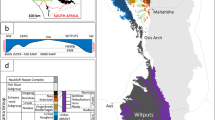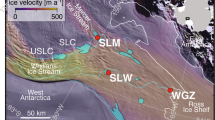Abstract
Reconstructions of the diversity of Precambrian microorganisms suggest a pronounced biotic turnover coinciding with the onset of Neoproterozoic low-latitude glaciation, in which diverse assemblages of organic-walled microfossils known as acritarchs were replaced by assemblages of simple, smooth-walled forms called leiosphaerids, and the remnants of bacterial blooms1,2,3,4. This turnover has been interpreted as the mass extinction of eukaryotic phytoplankton1,2,3,4 and the subsequent proliferation of bacteria5. However, the causes of this mass extinction and its exact temporal relationship to the glaciations remain unclear1,2,3,4. Here we present palaeontological data from the >742±6-Myr-old Chuar Group from Arizona, which indicate that the biotic turnover occurred before the first low-latitude (Sturtian) glaciation, constrained to be between 726 and 660 Myr in age6. In our record, the turnover is associated with the appearance of abundant and diverse protozoan fossils and a shift to rising total organic carbon, suggestive of increased primary productivity spurred by the influx of nutrients. This is followed by an increase in the ratio of highly reactive iron to total iron, which we interpret as persistent water column anoxia. We therefore conclude that the biotic turnover recorded in the Chuar Group was driven by widespread eutrophication of surface waters, rather than low-latitude glaciation.
This is a preview of subscription content, access via your institution
Access options
Subscribe to this journal
Receive 12 print issues and online access
$259.00 per year
only $21.58 per issue
Buy this article
- Purchase on Springer Link
- Instant access to full article PDF
Prices may be subject to local taxes which are calculated during checkout


Similar content being viewed by others
References
Vidal, G. & Knoll, A. H. Radiations and extinctions of plankton in the late Proterozoic and early Cambrian. Nature 297, 57–60 (1982).
Knoll, A. H. Proterozoic and Early Cambrian protists: Evidence for accelerating evolutionary tempo. Proc. Natl Acad. Sci. USA 91, 6743–6750 (1994).
Vidal, G. & Moczydłowska-Vidal, M. Biodiversity, speciation, and extinction trends of Proterozoic and Cambrian phytoplankton. Paleobiology 23, 230–246 (1997).
Moczydłowska, M. The Ediacaran microbiota and the survival of Snowball Earth conditions. Precambr. Res. 167, 1–15 (2008).
Knoll, A. H., Blick, N. & Awramik, S. M. Stratigraphic and ecologic implications of late Precambrian microfossils from Utah. Am. J. Sci. 281, 247–263 (1981).
Hoffman, P. F. & Li, Z.-X. A palaeogeographic context for Neoproterozoic glaciation. Palaeogeogr. Palaeoclimatol. Palaeoecol. 10.1016/j.palaeo.2009.03.013 (2009).
Timmons, J. M., Karlstrom, K. E., Dehler, C. M., Geissman, J. W. & Heizler, M. T. Proterozoic multistage (∼1.1 and ∼0.8 Ga) extension in the Grand Canyon Supergroup and establishment of northwest and north–south tectonic grains in the southwestern United States. Geol. Soc. Am. Bull. 113, 163–180 (2001).
Dehler, C. et al. High-resolution δ13C stratigraphy of the Chuar Group (about 770–742), Grand Canyon: Implications for mid-Neoproterozoic climate change. Geol. Soc. Am. Bull. 117, 32–34 (2005).
Dehler, C. M. et al. Neoproterozoic Chuar Group (∼800–742 Ma), Grand Canyon: A record of cyclic marine deposition during global climatic and tectonic transitions. Sedim. Geol. 141/142, 465–499 (2001).
Vidal, G. & Ford, T. D. Microbiotas from the Late Proterozoic Chuar Group (Northern Arizona) and Uinta Mountain Group (Utah) and their chronostratigraphic implications. Precambr. Res. 28, 349–389 (1985).
Porter, S. M. & Knoll, A. H. Testate amoebae in the Neoproterozoic Era: Evidence from vase-shaped microfossils in the Chuar Group, Grand Canyon. Paleobiology 26, 360–385 (2000).
Porter, S. M., Meisterfeld, R. & Knoll, A. H. Vase-shaped microfossils from the Neoproterozoic Chuar Group, Grand Canyon: A classification guided by modern testate amoebae. J. Paleontol. 77, 409–429 (2003).
Summons, R. E. et al. Distinctive hydrocarbon biomarkers from fossiliferous sediment of the Late Proterozoic Walcott Member, Chuar Group, Grand Canyon, Arizona. Geochim. Cosmochim. Acta 52, 2625–2637 (1988).
Ventura, G. T., Kenig, F., Grosjean, E. & Summons, R. E. 22nd International Meeting on Organic Geochemistry Vol. 2 Abstr. PB2–19 (Seville, 2005).
Weil, A. B., Geissman, J. W. & Van der Voo, R. Paleomagnetism of the Neoproterozoic Chuar Group, Grand Canyon Supergroup, Arizona: Implications for Laurentia’s Neoproterozoic APWP and Rodinia breakup. Precambr. Res. 129, 71–92 (2004).
Dehler, C. M. The Chuar Group-Uinta Mountain Group-Pahrump Group connection revisited: A snapshot of the infra-Sturtian Earth system. Geol. Soc. Am. Abstr. Prog. 40, 36 (2008).
Timmons, M. J. et al. Tectonic inferences from the ca. 1255–1100 Ma Unkar Group and Nankoweap Formation, Grand Canyon: Intractratonic deformation and basin formation during protracted Grenville orogenesis. Geol. Soc. Am. Bull. 117, 1573–1595 (2005).
Karlstrom, K. E. et al. Chuar Group of the Grand Canyon: Record of breakup of Rodinia, associated change in the global carbon cycle, and ecosystem expansion by 740 Ma. Geology 28, 619–622 (2000).
Williams, M. L. et al. Dating sedimentary sequences: In situ U/Th–Pb microprobe dating of early diagenetic monazite and Ar–Ar dating of marcasite nodules: Case study from Neoproterozoic black shales in the southwestern US. Geol. Soc. Am. Abstr. Prog. 35, 595 (2003).
Hill, A. C., Cotter, K. L. & Grey, K. Mid-Neoproterozoic biostratigraphy and isotope stratigraphy in Australia. Precambr. Res. 100, 281–298 (2000).
Vidal, G. & Nystuen, J. P. Micropaleontology, depositional environment, and biostratigraphy of the Upper Proterozoic Hedmark Group, southern Norway. Am. J. Sci. A 290, 170–211 (1990).
Gong, Y.-M., Shi, G., Weldon, E., Du, Y.-S. & Xu, E. Pyrite framboids interpreted as microbial colonies within the Permian Zoophycus spreiten from southeastern Australia. Geol. Mag. 145, 95–103 (2008).
Dehler, C. M., Porter, S. M., Grey, L. D. D., Sprinkel, D. A. & Brehm, A. in Proterozoic Geology of Western North American and Siberia (eds Link, P. K. & Lewis, R.) 151–166 (Special Publication 86, Society for Sedimentary Geology, 2007).
Richardson, K. & Jørgensen, B. B. in Eutrophication in Coastal Marine Systems (eds Jørgensen, B. B. & Richardson, K.) 1–19 (American Geophysical Union, 1996).
Diaz, R. J. & Rosenberg, R. Spreading dead zones and consequences for marine ecosystems. Science 321, 926–929 (2008).
Dehler, C. M. Facies Analysis, Cyclostratigraphy, and Carbon-Isotope Stratigraphy of the Neoproterozoic Chuar Group, Eastern Grand Canyon, Arizona. PhD, Univ. New Mexico (2001).
Swanson-Hysell, N. L., Maloof, A. C., Halverson, G. P. & Hurtgen, M. Covariation in the carbon isotopes of carbonate and organic carbon across the Neoproterozoic Bitter Springs Stage. Eos 89, Fall Meet. Suppl., Abstr. PP21B-1414 (2008).
Hurtgen, M., Halverson, G. P., Swanson-Hysell, N. L. & Maloof, A. C. Early Neoproterozoic sulfur isotopes and the rise (and fall) of oxygen. Eos 89, Fall Meet. Suppl., Abstr. PP14A-05 (2008).
Corsetti, F., Awramik, S. & Pierce, D. A complex microbiota from snowball Earth times: Microfossils from the Neoproterozoic Kingston Peak Formation, Death Valley, USA. Proc. Natl Acad. Sci. USA 100, 4399–4404 (2003).
Corsetti, F. A., Olcott, A. N. & Bakermans, C. The biotic response to Neoproterozoic snowball Earth. Palaeogeogr. Palaeoclimatol. Palaeoecol. 232, 114–130 (2006).
Acknowledgements
A. Knoll is thanked for providing several of the samples. The authors benefited from discussions with S. Awramik, J. Bartley, K. Grey, G. Halverson, P. Hoffman, M. Hurtgen, D. Johnston, R. Kodner, A. Maloof, M. Moczydłowska, D. Valentine, G. Ventura and M. Vogel. D. Lamb helped with acid macerations. V. Atudorei, Z. Sharp, and D. Des Marais provided laboratory support for TOC analyses. F. Corsetti and G. Shields provided comments that greatly improved the manuscript. Sampling collection was made possible by support from the National Park Service and from the National Science Foundation through grant EAR-9706496. Financial support to R.M.N. and S.M.P. for this research was provided by the National Science Foundation through grant EAR-0420592. Financial support to Y.S. was provided by NSERC.
Author information
Authors and Affiliations
Contributions
S.M.P. wrote the paper, with contributions from C.M.D. and Y.S. All authors contributed data (R.M.N., organic-walled microfossils; S.M.P., vase-shaped microfossils; C.M.D., total organic carbon; Y.S., iron speciation), and provided intellectual input.
Corresponding author
Supplementary information
Supplementary Fig. S1
Supplementary Information (PDF 576 kb)
Rights and permissions
About this article
Cite this article
Nagy, R., Porter, S., Dehler, C. et al. Biotic turnover driven by eutrophication before the Sturtian low-latitude glaciation. Nature Geosci 2, 415–418 (2009). https://doi.org/10.1038/ngeo525
Received:
Accepted:
Published:
Issue Date:
DOI: https://doi.org/10.1038/ngeo525
This article is cited by
-
A Review of the Neoproterozoic Global Glaciations and a Biotic Cause of Them
Earth Systems and Environment (2021)
-
Co-evolution of eukaryotes and ocean oxygenation in the Neoproterozoic era
Nature Geoscience (2014)
-
Extinction before the snowball
Nature Geoscience (2009)



